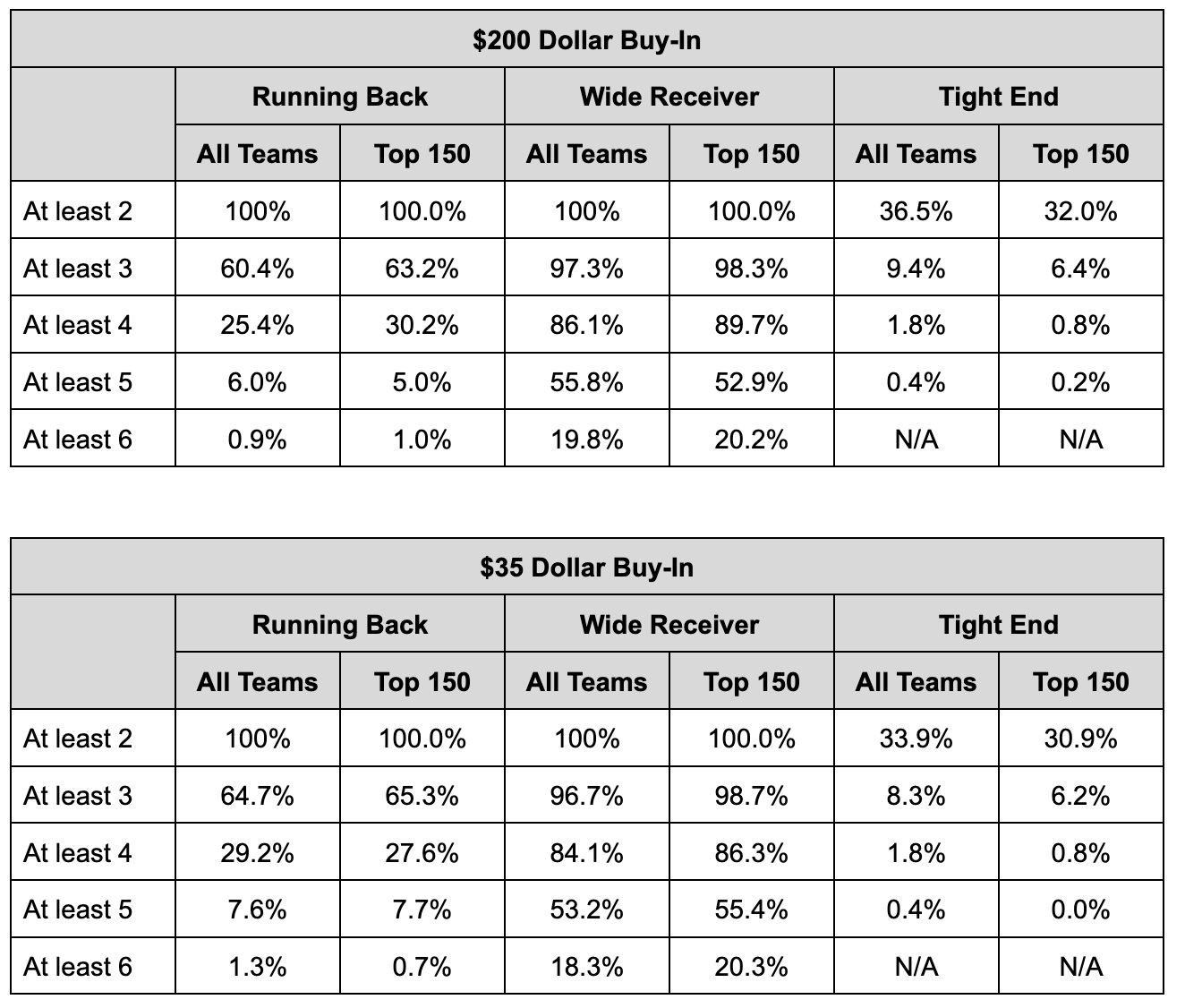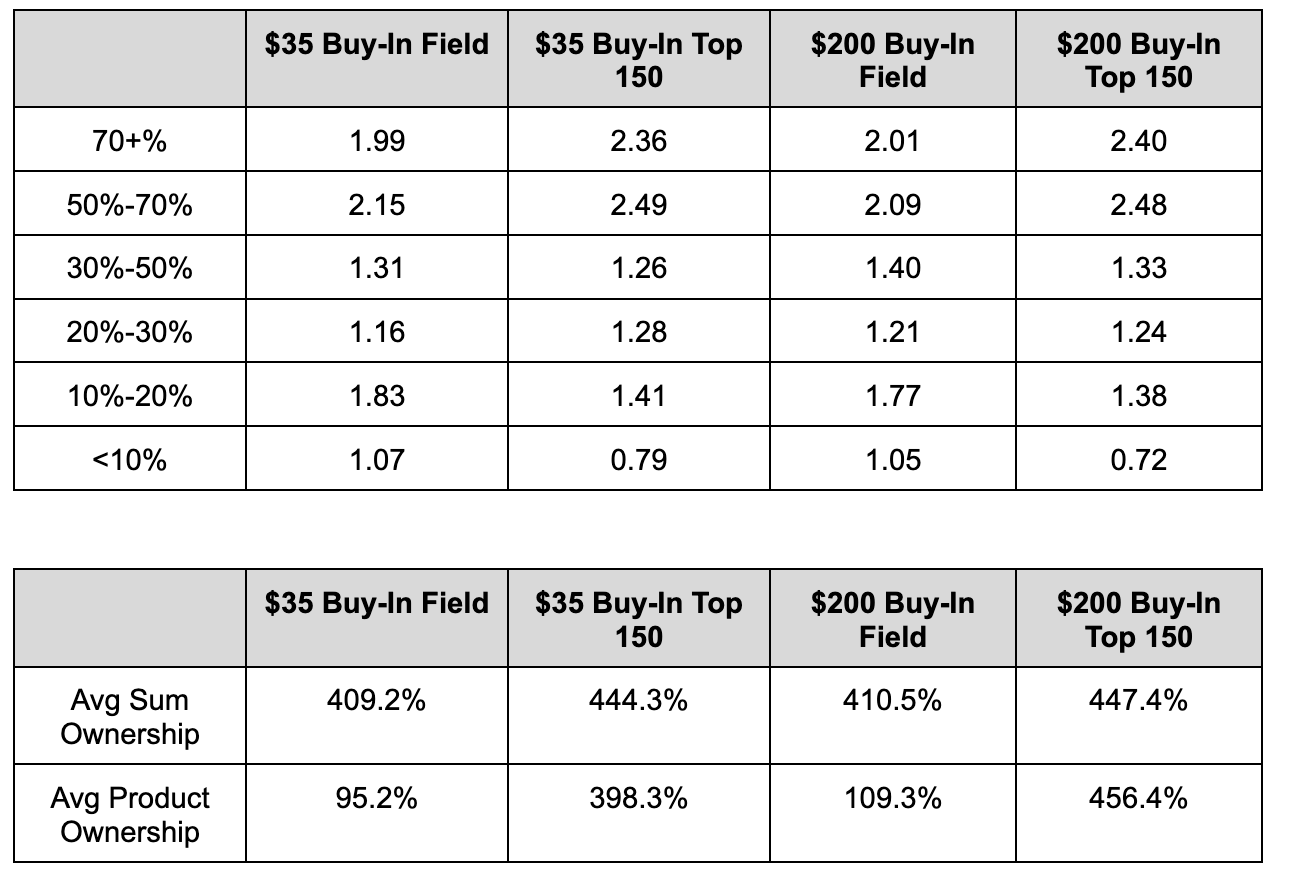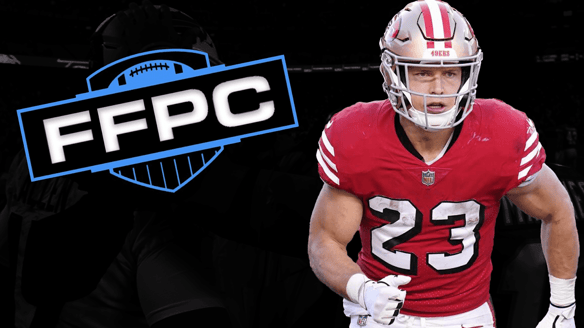The FFPC Playoff Challenge is one of my favorite fantasy football playoff tournaments to play every year. It has been around since 2018 but has taken form over the past few seasons. It is extremely unique in that it only allows you to select one player from each playoff team. I have collected data from the past three years of the tournament to uncover edges in the types of lineups that have done well each season.
First, I will review the rules to help explain the tournament and how to play if you have not heard of it before.
All of the information can be found on the FFPC site (use code POINTS at checkout).
FFPC offers both a $200 and $35 tournament. Both have the same rules, but the $35 tournament has about double the number of entries, so it will be slightly harder to win it all. At 16,000 total entries, it still isn’t anything like playing the Milly Maker each week on DraftKings, so it’s definitely not lottery-sized.
As I stated earlier, you can pick only one player from each playoff team to fill out a roster consisting of 1 QB, 2 RB, 2 WR, 1 TE, 4 FLEX (RB, WR, TE), 1 Kicker, and 1 Defense.
If you add up those roster spots, you will notice that you will be forced to choose no players from two of the playoff teams. These will be teams you are fading to not make it out of the wild card round. You also want to pick a kicker and defense from teams that will lose their first game.
The scoring is the same as any FFPC leagues: 4 points per passing TD, 6 for all other TDs, 1 point per 20 passing yards, 1 point per 10 rushing/receiving yards, and 1 point per reception — except tight ends, who get 1.5 points per reception (TE premium scoring). All points are doubled for players in the Super Bowl.
Defense scoring is typical of what you see in most leagues: 1 point for sacks, 2 points for an interception or fumble, etc. Defense scoring changed this season. Now you lose more points if your defense gives up points up to 30 points.
Now, with that out of the way, let's get into the fun information. My data analysis was mostly done on the top 150 rosters each season, dating back to 2020 to 2022.
How to Allocate FLEX Positions
How you choose to utilize your four FLEX positions can be very important to your chances of winning. Obviously, every year is somewhat different, and there will be better RBs, WRs, and TEs depending on the teams in the playoffs, but we can look for general trends of what works and what doesn’t. Below is a table showing the percentage of positions used in rosters of both all the teams in the tournament and the top 150 teams over the past three seasons.
In previous seasons, there used to be larger discrepancies between the roster structures of all teams and the top 150, but after three seasons, since the NFL expanded to 14 playoff teams, things have started to level out.
The one thing that usually was the largest edge was people overusing tight ends because of the 1.5 points per reception bonus. In 2022, the top 150 teams used 2+ tight ends 29.5% of the time, and all teams had 2+ tight ends at exactly the same rate. Whereas in 2020 and 2021, 2+ tight ends were utilized 40.6% of the time, but the top 150 teams only used them 33% of the time. I really would not force more than two tight ends, as it is still overused, and this year is a particularly bad pool of tight ends.
We can also see the importance of the wide receiver position. You are going to want at least four wide receivers on your team. If you don’t, you can get pretty chalky with the rest of your lineup since only 14% of the field will have no more than three wide receivers.
This was a strong year for running backs in the regular season, and it has carried over to the playoffs. I would not fault anyone for playing any of Saquon Barkley, Jahmyr Gibbs, Derrick Henry, James Cook, J.K. Dobbins, Kyren Williams, or Bucky Irving in the right builds. It is definitely viable to have four running back builds this season.
Games Played by Position
We will now examine the number of games played for each position on the top 150 teams over the past three seasons.
| Quarterback | 2020 | 2021 | 2022 | Total |
| 1 Game | 0.0% | 0.0% | 0.0% | 0.0% |
| 2 Games | 0.0% | 89.4% | 0.0% | 28.1% |
| 3 Games | 1.3% | 10.5% | 100% | 41.1% |
| 4 Games | 96.7% | 0.0% | 0.0% | 30.2% |
The above table shows that you want your QB to play at least 3 games. In 2020, Tom Brady was on 98% of the top 150 teams, and played in 4 games. 2021 was unique because the Rams and Bengals were not the favorites to reach the Super Bowl. Not only that, but Josh Allen played only two games but scored a whopping 81 fantasy points. To put that into perspective, Joe Burrow played in four games but scored only 78 points.
When choosing your QB, you need them to be extremely efficient, even if they play only two games. This year it will be extremely difficult to get away from Josh Allen or Lamar Jackson at QB. Neither has a bye, and both are big favorites in their first games. Not only that, if both do win in the wild card round like they are projected to do, they will then play each other, which guarantees one of them gets at least 3 games. You really have to ask yourself how another QB is more optimal than one of these QBs getting 3 games.
I would build in some potential wild card upset teams to make that more likely, like George Pickens or Courtland Sutton.
RBs on Top 150 Rosters (Games Played)
As we saw earlier, you can roster up to six running backs on your team using your FLEX positions. The table shows the number of games played for running backs gets very small past 3 RBs, because teams get eliminated in the playoffs, and it is rare for a team with 4+ RBs to make it into the top 150.
In general, it is rare for teams to have RBs that make deep runs into the playoffs. This makes intuitive sense because of the PPR scoring of FFPC — plus, over the past seasons of data, the NFL teams making deep playoff runs have had stronger passing attacks. The 2021 playoffs had Cooper Kupp, Ja’Marr Chase, and Tee Higgins outscoring RBs on their respective teams. The 2020 playoffs had the Buccaneers and the Chiefs in the Super Bowl — both had potent passing attacks. In 2022, Jalen Hurts was on every top 150 team, and the Chiefs had Travis Kelce.
All this should lead you to try and choose running backs who can be the highest scorer on their team, and if the team were to make a run in the playoffs, it would have to be because of them. Saquon Barkley, for example. James Cook makes a lot of sense on non-Allen teams. (If the Bills were to reach the Super Bowl, though, Allen likely would pull away.) Derrick Henry certainly could be the highest-scoring Ravens player.
Two of your skill players will be eliminated during the wild card round, though. 85% of the top 150 had a running back play only one game, so it is possible to pick a running back such as Josh Jacobs or Kyren Williams from an underdog team.
WRs on Top 150 Rosters to (Games Played)
Wide receivers' games are similar to running backs', mostly because of the success of quarterbacks and tight ends making deep runs, but we do see that WRs playing more games on your roster is important to some degree.
In the contest’s history, there hasn’t been a WR to play four games that you had to have on your team other than Cooper Kupp, and the Rams were not the favorites to make it to the Super Bowl that tear. We see a much larger percentage of top teams to roster at least 2 WRs to play 2+ games, but stop short of 3+.
It is not hard for an alpha wide receiver to have two big games in a row in a full PPR scoring system. 2020 Stefon Diggs, 2020 Davante Adams, 2021 Mike Evans, 2022 CeeDee Lamb, and 2022 Diggs were all on 90+% of the top 150 teams in their respective seasons and played exactly two games.
The main takeaway for wide receivers is that they provide the most flexibility of all the positions. In general, it is good to have a larger number of them because they have such high ceilings compared to everyone but quarterbacks, but also, you don’t need them to play a ton of games.
I don’t think this could be a year we see a high number of top 150 rosters containing a WR that played 4 games, with teams like the Eagles, Ravens, and Bills all with decent Super Bowl odds. Amon-Ra St. Brown could be the optimal pick from his team, but he is getting a max of 3 games. Many of the elite wide receivers don’t have great advancement odds — Puka Nacua, Nico Collins, and Justin Jefferson, for example.
TEs on Top 150 Rosters (Games Played)
The FFPC 1.5 PPR scoring for tight ends can make elite tight ends even more elite. No player has been more elite at the position than Travis Kelce, and he is the reason the above table shows the results that it does. In each of the past seasons of data, the Chiefs have played three playoff games, and 96.1% of the top 150 teams contained one tight end who plays at least three games.
Despite George Kittle, Rob Gronkowski, and Mark Andrews making the playoffs over the years with Kelce, it was extremely rare to have two tight ends on the same roster play a significant number of games. You likely are trying to thread a thin needle, hoping two elite TEs go far in the playoffs.
With 24% of teams only having one tight end on their roster play one game, it can be viable to punt the position in a way where a single-game team gets eliminated, but its tight end happens to put up a good score. But definitely do not try to guess two “punt” tight ends on the same team. Only 3% of top teams have two tight ends who each play only one game.
With Kelce clearly declining, I expect a big shakeup in the tight-end data this year. While it is possible Kelce gets it going again in the playoffs, we also may see tight ends not making deep runs this year because of him. That will make the punt-tight-end method more viable than usual. There really are no elite tight ends in the player pool this year if you remove declining Kelce and Mark Andrews. I would not be surprised if we saw a lot of top teams have only one tight end, and they were lost in the wild card round.
Kickers and Defenses
The only thing you need to know about kicker and defense games played is that you want yours to play only one game. Kickers and defenses will not outscore QBs or skill position players over multiple games, so you should focus on choosing your kicker and defense from teams you do not expect to win.
How to Differentiate Your Roster
You will, without a doubt, hear that you need to differentiate your lineup and can’t just play the best player from each team. While it is definitely true to try and make a lineup that won’t cause you to tie with 100 other teams, you also don’t want to try and get cute in the wrong ways.
The top six most-rostered players on the top 150 teams in 2022 were Travis Kelce (100%), Jalen Hurts (100%), Christian McCaffrey (97%), Stefon Diggs (96%), Saquon Barkley (95%), and CeeDee Lamb (91%). Only Hurts and Diggs were not the highest-owned players on their teams by the field. Josh Allen was only 4% more owned than Diggs, and rostering Allen meant you couldn’t roster Hurts. Despite many of those players being the far-and-away favorite on their team, McCaffrey came in the highest ownership at 77%, so they were all under-owned.
Now that isn’t always the case. Ja’Marr Chase was the most popular Bengal at 65% owned but showed up on 0% of the top 150 teams. However, Justin Jefferson was 77% owned and 75% owned in the top 150 despite being significantly worse than his teammate T.J. Hockenson in their singular game in 2022.
All this means is that — unless you are building a lot of teams — you really don’t need to fade the top best plays and likely only fade one or two of the next tier. To me, this year, the “lock them in” players are Nacua and probably Jefferson, with Barkley being close. You can get creative with the rest of the teams, but you don’t have to get creative with all of them.
The two tables above show how people get way too carried away with trying to be different — this isn’t a DFS GPP. In both tournaments, the top 150 teams had more players that were 70+% owned and 50-70% owned on average than the rest of the field. Where they get different is in the 20-30% ownership range. You don’t have to go down to the lowest percentage of owned players. Just adding more players that are 10-30% owned compared to 30-50% owned can go a long way.
Both product and sum ownership were higher for the top 150 teams than the rest of the field. You do have to be a little more contrarian in the $35 tournament because there are more teams, but not too much more contrarian. I will have my projected ownership in a link below that I will update until the first kickoff.
One last note on choosing your defense. FFPC scoring is unique in that your defense stops losing points after giving up 10 points. If you’ve watched many games this season, you likely know giving up fewer than 10 points in any game is extremely rare, except for the best teams. However, you don’t want to waste a good team by taking their defense. Basically, don’t worry about choosing a defense that can get blown out and instead focus on defenses that can generate sacks and turnovers — the Denver Broncos come to mind. They are projected to give up a ton of points but this is a good defense that maybe can get some sacks and turnovers along the way.
The Jaguars were the highest-rostered defense in 2022 at 20%, and ended up on 0% of top-150 teams. The Dolphins, on the other hand, were only rostered on 3% of all teams and 7% of the top 150 teams, and they scored 19 fantasy points. That was the highest score for a single-game defense in the playoffs last season, which is exactly what you are targeting.
A good defense won’t be the reason you reach the top 150, but it can be the difference in finishing 150th and 1st.
*UPDATE - Defense scoring changed this season. Now you will lose points up your defense giving up 30+ points. This is different from previous seasons where you would stop losing points after your defense gave up 10+ points. This makes a defense like the Broncos worse but don’t overreact either. You still want your defense to lose anyway.
Usable Player Pool (Favorite Plays Bolded)
NOTE: Because only 12 players will be on your roster, you have to choose to FADE two teams entirely. Obviously, you want these to be two teams that lose in the Wild Card round.
Kansas City Chiefs: Travis Kelce, Patrick Mahomes, Xavier Worthy (Leverage), Hollywood Brown, Fade, Harrison Butker
Buffalo Bills: Josh Allen, James Cook, Dalton Kincaid (Leverage)
Houston Texans: Nico Collins, Fade, Dalton Schultz (Leverage), Kai’imi Fairbairn, HOU Team Defense
Baltimore Ravens: Lamar Jackson, Mark Andrews, Derrick Henry
Philadelphia Eagles: Saquon Barkley, A.J. Brown, Jalen Hurts, DeVonta Smith
Green Bay Packers: Fade, Josh Jacobs (Leverage), Tucker Kraft, Brandon McManus
Los Angeles Rams: Kyren Williams (Leverage), Puka Nacua, Fade, LAR Defense
Tampa Bay Buccaneers: Bucky Irving, Mike Evans, TB Defense, Chase McLaughlin
Minnesota Vikings: Justin Jefferson, Jordan Addison (Leverage), Fade, MIN Defense, Will Reichard
Washington Commanders: Terry McLaurin, Zach Ertz, Jayden Daniels, Fade, WAS Defense, Zane Gonzalez
Los Angeles Chargers: Ladd McConkey, J.K. Dobbins, LAC Defense, Cameron Dicker
Pittsburgh Steelers: Fade, PIT Defense, George Pickens (Leverage), Pat Freiermuth, Chris Boswell
Denver Broncos: DEN Defense, Fade, Courtland Sutton, Will Lutz
Detroit Lions: Jahmyr Gibbs, Amon-Ra St. Brown, Sam LaPorta (Leverage)
Projected Ownership
You can find my player ownership projections here — I will update until kickoff for the first game.
Finally, HAVE FUN! Use this link to enter the FFPC Playoff Challenge (use code POINTS at checkout).












